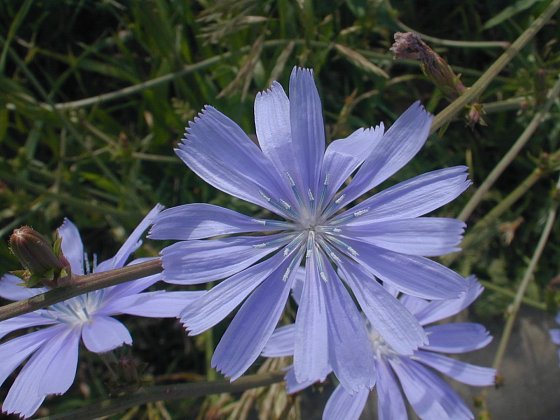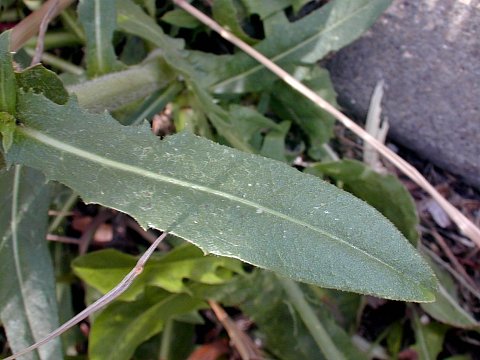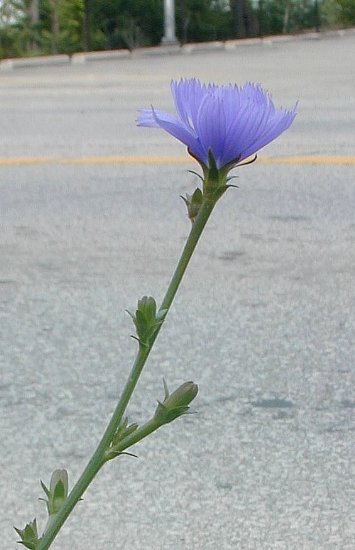Description: This annual or biennial plant is usually 1½–3' high, branching occasionally. The stems are variously colored, ranging from green to reddish brown. The lower stems can be quite hairy, while the upper stems are nearly hairless. The alternate leaves are up to 8" long and 2" across, becoming smaller as they ascend the stems. They are lanceolate, elliptic, or oblanceolate in overall shape, and either pinnatifid or dentate; the upper leaves have margins that are more smooth (entire). Each leaf narrows gradually to a petiole-like base, where it is either sessile or clasps the stem. There are usually conspicuous hairs along the central vein of the lower leaf surface.

The upper stems terminate
in long inflorescences that are either spike-like, or they are
open branching panicles. Widely spaced along the flowering stalks,
there are sessile or nearly sessile flowerheads and short triangular
bracts. These flowerheads are about 1-1½" across and they have
10-20 ray florets. The petaloid rays of these
florets are light blue, fading to white; there are 5 tiny
teeth at the tip of each petaloid ray. Toward the center of each
flowerhead, there are several light blue stamens with blue anthers. The
flowerheads bloom during the morning, and close-up later in the day,
unless the skies are cloudy. The blooming period can occur from early
summer to early fall, depending on the weather and the timing of
disturbances (such as occasional mowing). The achenes are oblongoid and
5-ribbed; there is a pair of small scales at the apex
of each achene. The root system consists of a stout taproot. Common
Chicory spreads by reseeding itself.
Cultivation:
Common Chicory appears to prefer full sun and a heavy soil that
contains clay or gravel. This plant is typically found in locations
that are mesic to dry, and it withstands drought rather well. Road salt
and alkaline conditions are tolerated better than most plants.
The foliage can appear rather battered-looking by the end of a hot dry
summer.

Range &
Habitat:
The non-native Common Chicory has been reported in nearly all areas of
Illinois, except a few counties in the NW and SE sections of the state
(see Distribution
Map). It is quite possible that Common Chicory occurs in
those counties as well. This plant originated from Eurasia, and was
present in Illinois by the late 19th century. It has been spreading
steadily ever since and has become common, particularly in disturbed
open areas. Typical habitats include pastures, abandoned fields, areas
along roadsides and railroads, grassy areas that are not mowed
regularly, undeveloped real estate lots, and other waste areas.
Occasionally, Common Chicory colonizes disturbed areas of natural
habitats (e.g., early stages of a prairie restoration), but it is not a
serious invader of such natural areas in the long run.
Faunal Associations:
The flowers attract short-tongued bees and probably other insects. Both
nectar and pollen are available as floral rewards. The foliage of
Common Chicory is eaten by Melanoplus
bivittatus (Two-Striped Grasshopper), Melanoplus femurrubrum
(Red-Legged Grasshopper), and probably other grasshoppers. The larvae
of a lizard beetle, Acropteroxys
gracilis, bore through the stems of this plant, while the
caterpillars of the moth, Pyrrhia
exprimens (Purple-Lined Sallow), feed on the the flowers,
buds, and developing achenes. Because the foliage contains a bitter
white latex, it is probably not preferred as a food
source by mammalian herbivores, although cattle and sheep reportedly
eat the basal leaves.

Photographic
Location:
Along a roadside in Urbana, Illinois.
Comments:
The roots of Common Chicory have been roasted to create a
coffee-substitute; they are also used as an ingredient in some herbal
teas. The flowerheads are very beautiful, but short-lived. This species
is easy to identify because of the appearance of these flowerheads –
they are a lovely light blue, whereas similar plants in the Aster
family usually have yellow flowerheads. However, some Lactuca spp. (Wild
Lettuce) have light blue flowerheads that are smaller in size.
These latter species produce achenes with tufts of hair, whereas the
achenes of Common Chicory have only small scales.